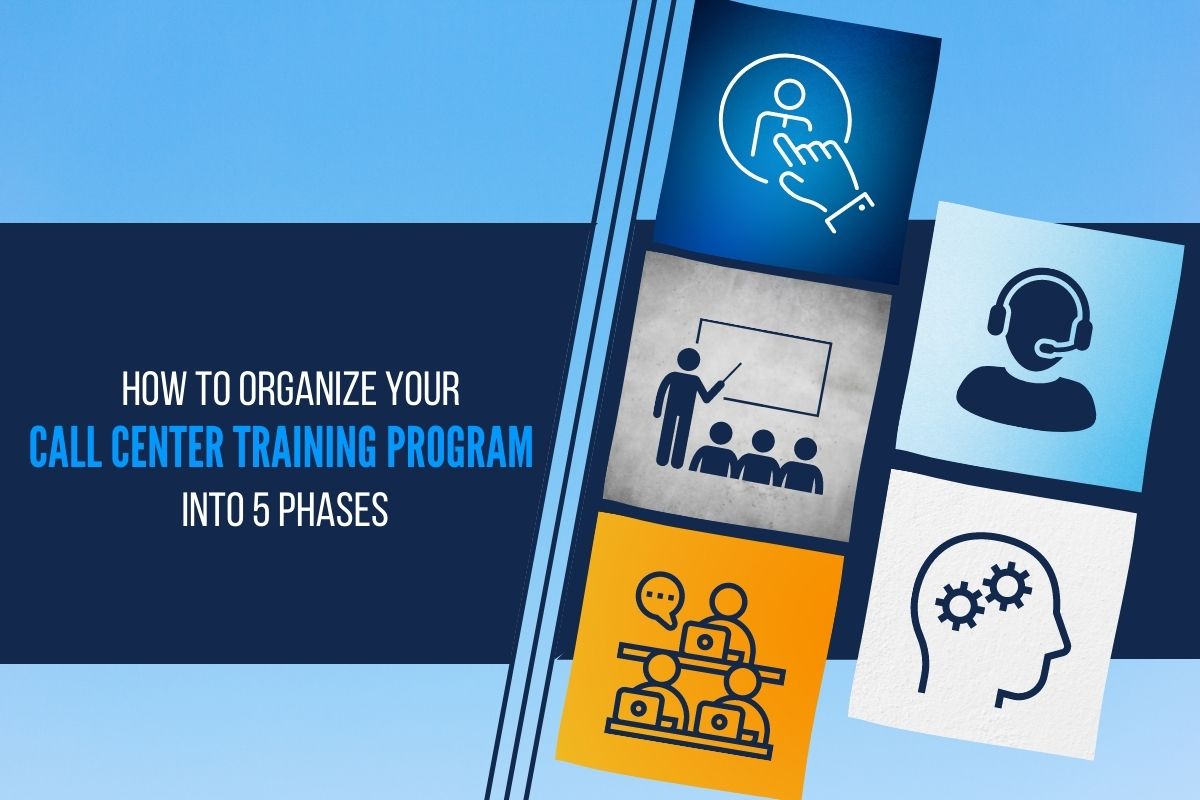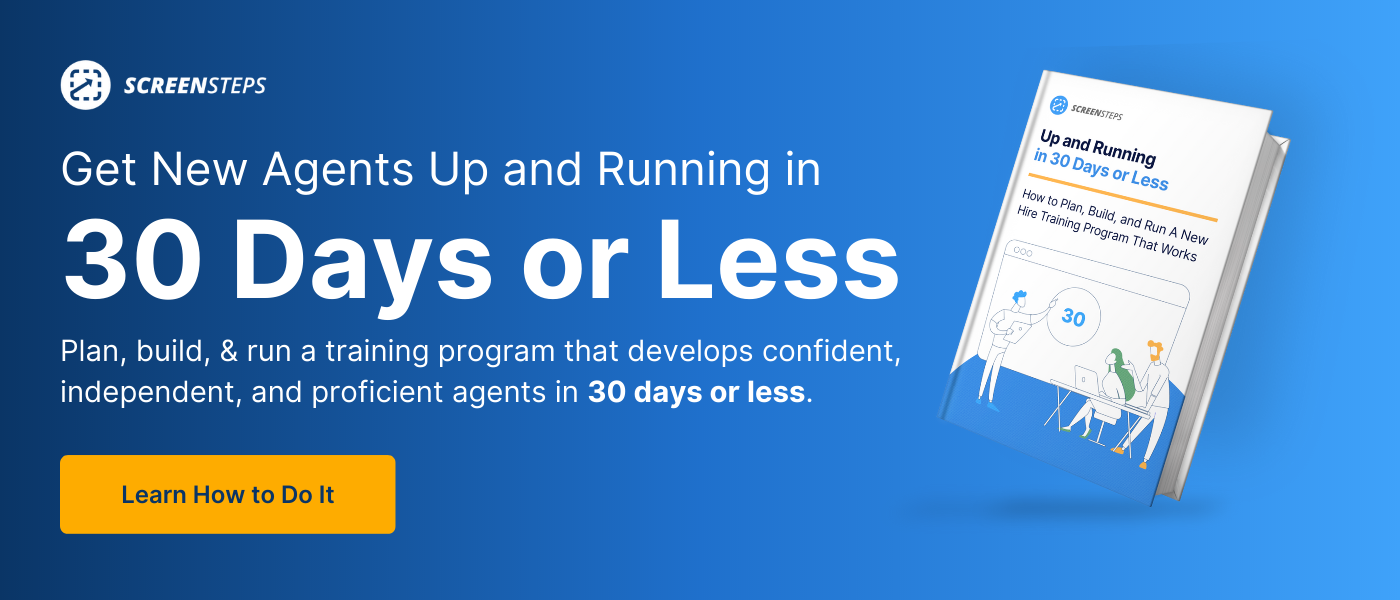How to Organize Your Call Center Training Program Into 5 Phases
Onboarding new call center agents takes patience, time, and money. As much as you wish you could teach a few lessons and the new agents would be ready to take any call, that’s not how training is going to happen. It happens in increments.
Think of how video games start off easy to help the player learn the basic moves. In Mario, the first level is very basic, helping the player learn how to go forward, backward, duck, and jump.

You don’t advance to the next level until you’ve gained the new skills you need to move forward. Then, in the next level, you continue to learn new moves.
It’s the same when you are onboarding new agents for your contact center. They need to be taught a little bit at a time, building on the knowledge they gain in training each day.
Working with ScreenSteps customers to organize training programs, I’ve seen how a knowledge base helps simplify the onboarding process. With a ScreenSteps knowledge base, agents can learn bit-by-bit since they always have call flows and procedures to reference 24/7.
These five phases will help you break down your call center training — whether you have a knowledge base or not — so that you don’t accidentally throw your new hires into a Level 5 situation when they only have the skills (or base knowledge) for Level 2.
Below, I explain what the five phases are and what you should cover in each stage of training.
Phase 1: New hire orientation (1-3 days)
When you are onboarding new agents, your employees are starting from zero. They know nothing about your company and your systems.
Start training with 1-3 days of new hire orientation where new agents are introduced to an overview of your company and basic background information on procedures. Some elements to include in new hire orientation are:
Get to know the new agents
The first couple of days should be spent getting to know reps and making them feel comfortable with others in their class and with the instructor.
Don’t underestimate how important it is for everyone to chat with each other and meet others. If reps don’t feel comfortable or like they belong, chances are they will ghost you. That is, new reps quit in the middle of training.
Reps have no problem with ditching a call center if they’re not liking it. Add ice breakers and other activities to the first few days of training to help them feel like a part of the team.
Provide an overview of the products, services, and systems
What type of software do they need to know to do their jobs? What products and services does your company offer? Give high-level overviews of the products, services, and systems they will be using to do their job.
This doesn’t need to be an in-depth presentation. It just needs to be enough information to help introduce new agents to what they will be dealing with day-in and day-out.
You can even turn these introductions into games, like matching, a scavenger hunt, or other challenges.
Provide background information for the types of calls they will handle
Provide scope for the types of calls your contact center agents will be answering. One way to introduce your new agents to these calls is by sharing examples. You can play recordings of previous calls and let them listen in.
Phase 2: Classroom/virtual training (14-60 days)
Once your new reps have some background knowledge about the systems, the calls, and your company, it’s time to jump right in with practice calls.
During the 14-60 days of classroom and/or virtual training, there are many ways to approach training in this phase. Your call center training program can involve many different types of training.
Lectures & Presentations
Often, lectures and PowerPoint presentations are the default training method for call centers. Sometimes trainers use printed documents to supplement training or account for anything they may have missed.
This type of training often relies on agents memorizing the information they are sharing. Ultimately, it takes longer to onboard agents using lectures because you have to cover every single detail about your company’s policies, processes, and procedures.
🔍 Related: 4 Strategies for Remote Call Center Training
Scenario-based training
While scenario-based training can involve lectures and PowerPoint presentations, scenario-based training focused more on providing new hires hands-on experience.
New hires role-play realistic scenarios of different types of calls they will handle. If you have call flows and job aids, scenario-based training allows your new agents to practice following the scripts and procedures while on a call.
Note: Scenario-based training works best if your company has a single source of truth — a centralized location for all your company’s resources — that houses all your documented policies, processes, and procedures. That could be a document library or knowledge base.
Training on a pyramid
Start with the simplest calls your agents will handle then gradually add on more complex calls.
Remember the video game example from the beginning of this article?
Use that principle in your training. The first few days should be very simple scenarios with the purpose of helping your reps learn how to use your knowledge base (or wherever you store your call flows and other resources) to answer questions.
🔍 Related: 5 sections to include in your call center training manual
Example call center training schedule
For a 14-day training classroom/virtual experience, here’s one way you could break down your call center training schedule. You can include lectures and presentations each day surrounding the new call or task you have agents practice.
If you have more content to cover, you can add similar days following this pattern.
|
Days of Training |
Content Covered |
|
Day 1-2 |
|
|
Day 3-5 |
|
|
Day 6-8 |
|
|
Day 9-14 |
|
|
Day 15- End of Classroom Training |
|
Phase 3: Shadowing(1-2 weeks)
Following classroom training, new agents are moved to the shadowing phase. Shadowing is a phase in call center training where your new hires observe how experienced agents take calls.
Note: Some call centers have reps start shadowing as part of their classroom training phase.
In this phase, new agents are either paired with tenured agents to listen to live calls or they listen to previously recorded calls. New hires observe how your tenured agents answer calls and use your tools and resources to help the callers.
Ideally, your new hires will have call flows and procedures that they can follow along with as the experienced agent handles the call. That will give new agents a chance to move through scenarios in real-time.
Warning: If your new agents shadow a tenured rep who doesn’t really follow any procedures and goes completely from memory, it can be a confusing experience for your reps in training. That’s because what they are learning doesn’t match what other reps are actually doing.
Phase 4: Nesting/coaching (1-3 weeks)
Now that your new agents have been listening to real calls, they are ready to start taking calls on their own. To make it less intimidating, the nesting phase gives new reps a “buddy” who can step in if they get stuck.
This can be the same tenured agent who the new hire shadowed or another experienced agent. The point of the phone coach is to be available to help out if necessary.
The phone coach might listen in on every call or they might periodically check in and provide feedback to the rep. This phase lasts for 1-3 weeks.
Tip: Make sure the tenured agents you choose to help in the nesting phase follow the procedures you teach in training. When new reps are coached by a tenured agent who does things “their” way and not the approved way, reps become confused about which approach is best and they lose trust in your documented procedures.
🔍 Related: How to Make Call Center Training Less Stressful For Your Agents (4 Tips)
Phase 5: Continuous Learning (Ongoing)
At this point, your new reps should be fully proficient. But this does not mean that your new reps are experts at handling calls. It means they have enough skills and understanding to get by on the job. However, there is always room for improvement and to learn new skills or how to handle new calls.
As your reps take calls, provide them additional learning opportunities such as additional courses, lunch and learn, videos, etc.
The idea is that as your reps handle calls, they are going to develop additional questions around those topics. Those moments when reps have additional questions are the perfect time to provide more detailed, in-depth answers.
Continuous learning opportunities can come in the form of quizzes, self-paced courses, videos, etc. These materials — which could be housed in a learning management system (LMS) — challenge agents and require them to have a deeper understanding of the topics and materials.
Workflow learning
Another part of continuous learning is workflow learning. This is just-in-time training that helps reps learn how to do new tasks at the same time they are learning how to do them.
This approach helps when you always have agents use your documented procedures. Then they can adjust and learn faster when there are changes to call flows or procedures.
🔍 Related: 5 Ways to Incorporate Continuous Learning in Your Workplace
Want your new agents to reach proficiency faster?
Breaking your call center training program into these five phases creates stepping stones for your new agents to learn everything they need for their job.
Don’t have three months to train your call center agents? It will always take time and money to train your new agents, but it doesn’t have to take extensive weeks or months to onboard new reps.
Using a ScreenSteps knowledge base, our clients have decreased the amount of time spent training by up to 90%. One contact center went from spending 60 days in training to just 15 days. This means your agents are proficient faster and you can get them on the phones faster.
Learn more about time to proficiency — what it has to do with training, how much it costs your call center, and how to decrease the time it takes for new agents to become proficient — with the article below.


.png)


